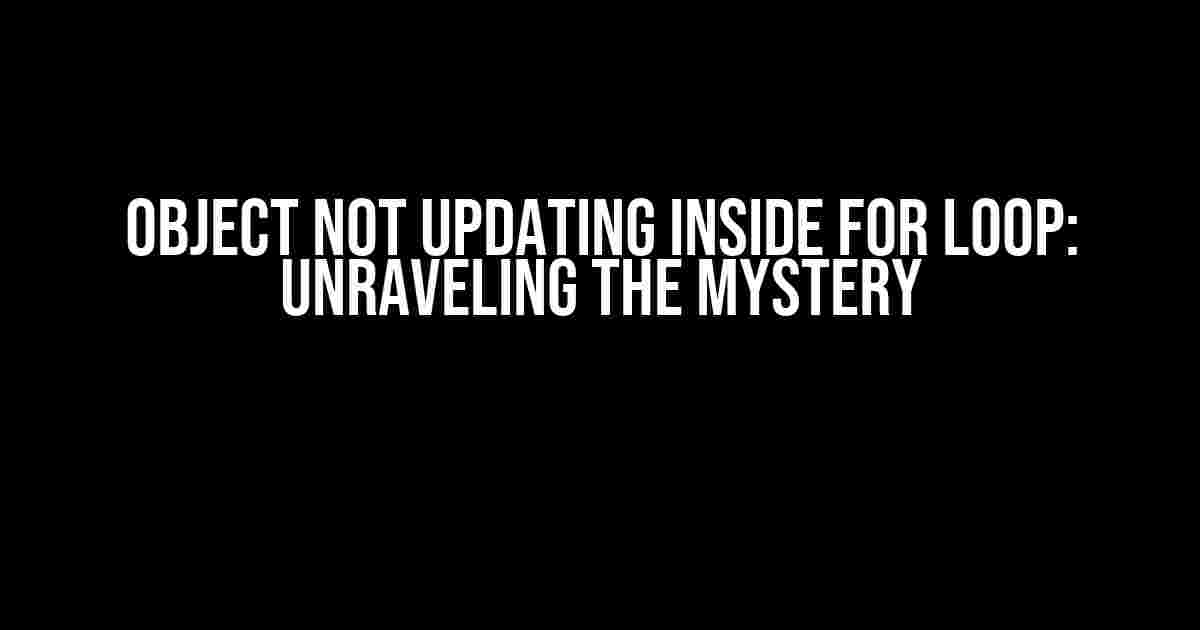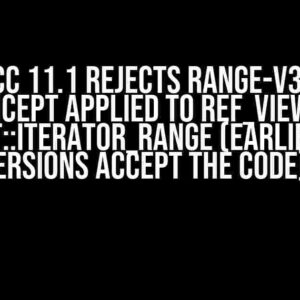Are you stuck in the vicious cycle of confusion, where your object refuses to update inside a FOR loop? Fear not, dear developer, for you’re not alone! This frustrating phenomenon has plagued many a programmer, leaving them scratching their heads and wondering what dark magic is at play. But fear not, for today, we shall conquer this beast and emerge victorious! In this article, we’ll delve into the depths of JavaScript, FOR loops, and object mutability to uncover the secrets behind this enigmatic issue.
The Problem: Object Not Updating Inside FOR Loop
Let’s set the stage: you have an array of objects, and you’re trying to update each object within a FOR loop. Sounds simple, right? Well, as it turns out, simplicity can be deceiving. When you attempt to update an object inside the loop, nothing seems to change. It’s as if the object is stuck in a time warp, refusing to acknowledge the updates. Here’s an example to illustrate the issue:
let arr = [
{ id: 1, name: 'John' },
{ id: 2, name: 'Jane' },
{ id: 3, name: 'Bob' }
];
for (let i = 0; i < arr.length; i++) {
arr[i].name = 'New Name';
console.log(arr[i].name); // Outputs: New Name (but the original array remains unchanged)
}
console.log(arr); // Outputs: Original array with no updates
The Culprit: Object References and Mutability
So, what’s going on here? Why does the object refuse to update? The answer lies in the nature of objects and how they’re handled in JavaScript. You see, when you create an object, it’s not a primitive value like a number or string. Instead, it’s a reference to a location in memory where the object’s properties are stored. This means that when you assign an object to a new variable or pass it as an argument to a function, you’re not creating a copy of the object; you’re simply creating a new reference to the same object.
This concept is crucial to understanding why the object isn’t updating inside the FOR loop. When you iterate over the array using a FOR loop, you’re working with a reference to each object, not the object itself. Any changes you make to the object will affect the original array, but only if you’re careful about how you update the object.
Solutions: Unleashing the Power of Object Mutability
Now that we’ve identified the problem, it’s time to explore the solutions! Here are a few approaches to updating objects inside a FOR loop:
Method 1: Create a New Object and Update the Array
In this approach, you create a new object for each iteration and update the array with the new object. This ensures that the original array is updated correctly:
let arr = [
{ id: 1, name: 'John' },
{ id: 2, name: 'Jane' },
{ id: 3, name: 'Bob' }
];
for (let i = 0; i < arr.length; i++) {
let newObj = { ...arr[i], name: 'New Name' }; // Create a new object with updated properties
arr[i] = newObj; // Update the array with the new object
}
console.log(arr); // Outputs: Updated array with new object values
Method 2: Use the `Object.assign()` Method
Another approach is to use the `Object.assign()` method, which creates a new object by merging the properties of the original object with the new properties:
let arr = [
{ id: 1, name: 'John' },
{ id: 2, name: 'Jane' },
{ id: 3, name: 'Bob' }
];
for (let i = 0; i < arr.length; i++) {
Object.assign(arr[i], { name: 'New Name' }); // Update the object using Object.assign()
}
console.log(arr); // Outputs: Updated array with new object values
Method 3: Use the Spread Operator ({ … })
Yet another approach is to use the spread operator ({ … }) to create a new object with the updated properties:
let arr = [
{ id: 1, name: 'John' },
{ id: 2, name: 'Jane' },
{ id: 3, name: 'Bob' }
];
for (let i = 0; i < arr.length; i++) {
arr[i] = { ...arr[i], name: 'New Name' }; // Update the object using the spread operator
}
console.log(arr); // Outputs: Updated array with new object values
Best Practices: Avoiding the Pitfalls
Now that we’ve covered the solutions, let’s discuss some best practices to keep in mind when working with objects and FOR loops:
- Avoid direct assignment: When updating an object, avoid direct assignment using the `=` operator. Instead, use one of the methods mentioned above to create a new object or update the existing one correctly.
- Use `let` or `const` declarations: When iterating over an array, use `let` or `const` declarations to ensure that you’re working with a new scope for each iteration.
- Make copies of objects: When working with objects, make copies of them to avoid unintended changes to the original object.
- Use debugging tools: Use debugging tools like console.log() or a debugger to visualize the execution of your code and identify issues.
Conclusion: Mastering Object Mutability
And there you have it, folks! With these solutions and best practices, you’re now equipped to tackle the pesky issue of objects not updating inside FOR loops. Remember, the key to success lies in understanding the nuances of object references and mutability in JavaScript. By being mindful of these concepts and using the right techniques, you’ll be able to update objects with confidence and precision.
So, the next time you encounter this issue, don’t panic! Take a deep breath, recall the wisdom imparted in this article, and conquer the problem with ease. Happy coding!
| Solution | Description |
|---|---|
| Method 1: Create a New Object and Update the Array | Create a new object for each iteration and update the array with the new object. |
| Method 2: Use the `Object.assign()` Method | Use the `Object.assign()` method to create a new object by merging the properties of the original object with the new properties. |
| Method 3: Use the Spread Operator ({ … }) | Use the spread operator ({ … }) to create a new object with the updated properties. |
Frequently Asked Question
Stuck in a loop? Don’t worry, we’ve got you covered! Here are some FAQs about objects not updating inside a FOR loop:
Why is my object not updating inside a FOR loop?
This is a common issue in programming languages like JavaScript, where the object is being referenced by value, not by reference. This means that any changes made to the object inside the loop are not reflected outside the loop. To fix this, you can use a workaround like creating a new object or using an array of objects instead.
Is it possible to update an object inside a FOR loop in JavaScript?
Yes, it is possible to update an object inside a FOR loop in JavaScript, but it requires some extra steps. You can use the `Object.assign()` method to create a new object and update its properties, or use a library like Lodash to clone the object and update its properties.
What is the difference between pass-by-value and pass-by-reference in programming?
Pass-by-value means that a copy of the original value is passed to a function or loop, and any changes made to the copy do not affect the original value. Pass-by-reference means that a reference to the original value is passed, and any changes made to the reference affect the original value. In the context of object updating inside a FOR loop, pass-by-reference is what we want, but JavaScript uses pass-by-value by default.
How can I ensure that my object is updated correctly inside a FOR loop?
To ensure that your object is updated correctly inside a FOR loop, use a debugger to check the values of your object at each iteration. Also, make sure to use the correct syntax and methodology for updating the object, and consider using a library or framework that provides better support for object updating.
Can I use arrow functions to update an object inside a FOR loop?
Yes, you can use arrow functions to update an object inside a FOR loop, but be careful with the scope of the `this` keyword. Arrow functions have a lexical scope, which means that `this` refers to the parent scope, not the current scope. Make sure to use the correct syntax and binding to update the object correctly.





